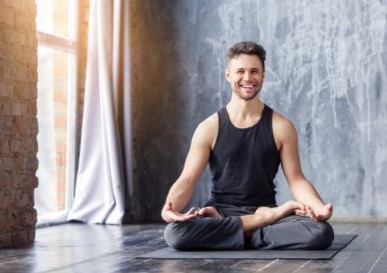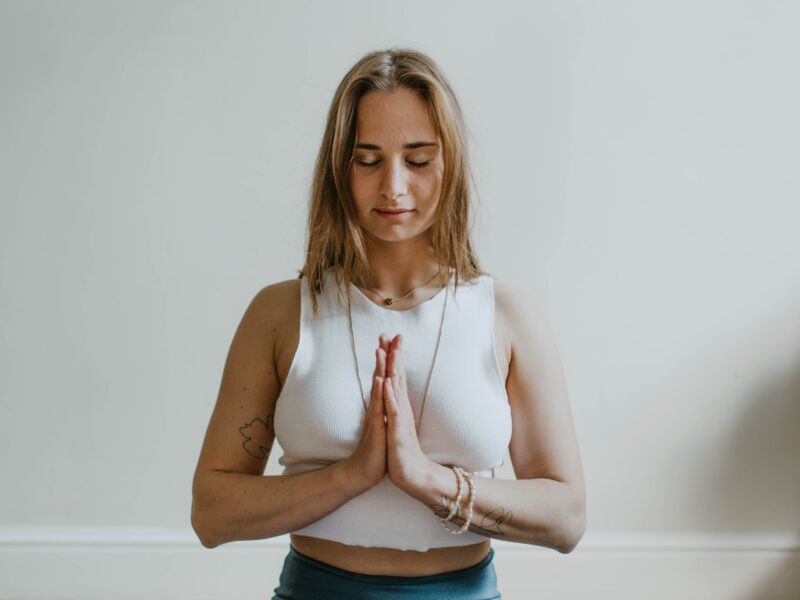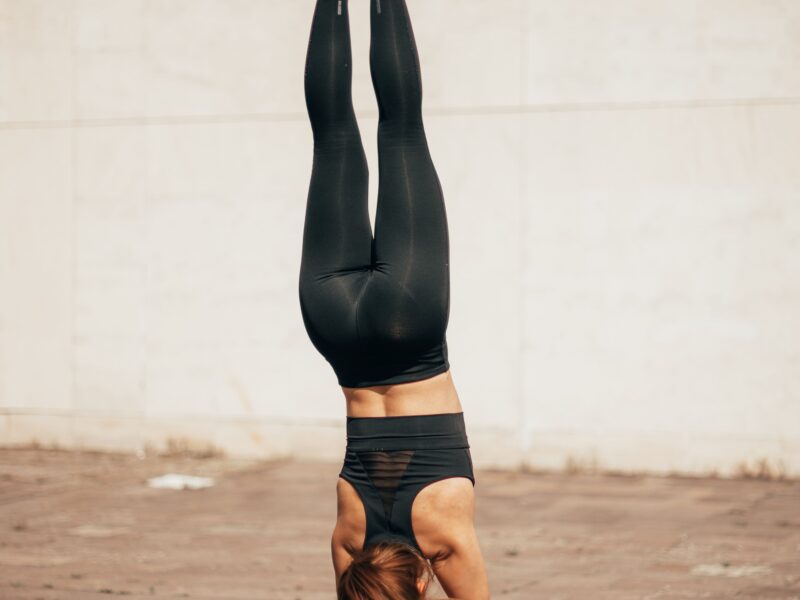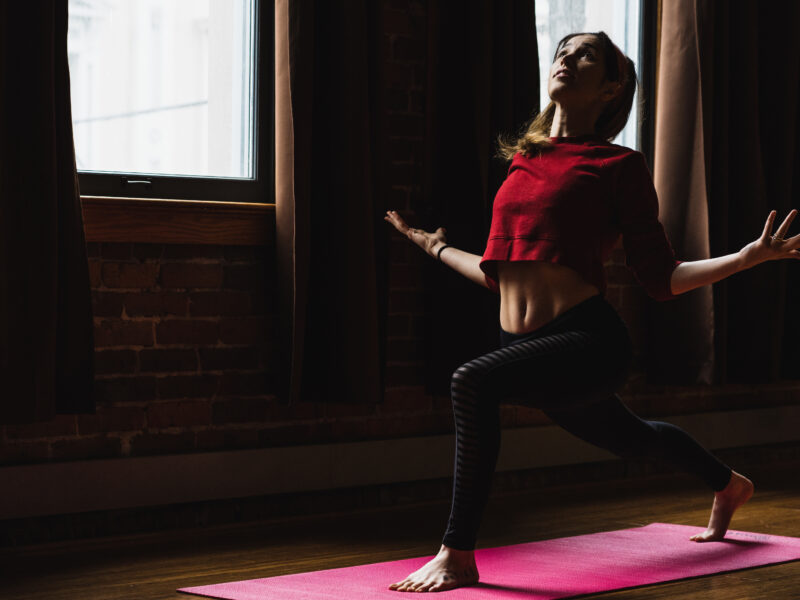Savasana, or Corpse Pose, is one posture you can’t live without. You need it for the fullest experience of yoga and a deep connection with your vital energies.
By John Hanc
Illustrations by Andrea Cobb
There I was, cocooned in warmth and darkness, feeling as light as air and as relaxed and carefree as a million-dollar Lotto winner on a Caribbean beach. I might have been a space traveler in suspended animation, rocketing off at light speed to a new solar system, or even an infant in the womb, except that I had a vague sense I was watching myself in a state of what could best be described as alert relaxation.
Begin to bring awareness to your inhalation …That voice… so familiar. Cautiously, I opened one eye and found that I was not floating along on a river of soothing darkness or soaring through the outer reaches of the Milky Way, but lying motionless on the floor of Om Tara Yoga Studio in Massapequa, New York. When you’re ready, gently roll to one side … observe how you feel … It was Maria Yakkey, my regular Thursday-morning yoga teacher. Soon, a half-dozen classmates and I were alert and energized, sitting in Sukhasana (Easy Pose) with our legs crossed, bowing to the Divine within.
Namaste. Then class was over. As I was clearing up my props, Maria came over. “John,” she said. “You’re really getting better at Savasana.” I almost dropped a pair of blocks on my foot. Better? At Savasana? You mean, my ability to imitate a corpse has improved?
“You used to be more fidgety,” she said. Understand: I’m an overcaffeinated, Type A New York guy—and on top of that, I’m an avid marathon runner and gym rat. Of course I’m fidgety, and it’s clear to me that I need yoga. Still, I thought, of all the things I haven’t done well in my seven years of practice—which, to my mind, was almost everything—surely, lying quietly on the floor was the exception.
“So,” I said, “I’m getting better at lying on the floor?” Maria sighed and looked at me reproachfully. “Savasana is a lot more than just lying on the floor.”
Now, don’t get me wrong: I enjoy that delicious rest at the end of class. But until I gave it serious consideration, I thought of Savasana as a yogic chill pill, built into the end of practice to calm yuppies and soccer moms before they climb back into their SUVs and start texting their way to the nearest Starbucks.
But Maria is right. Savasana is much more. This traditional Indian yoga practice is a very purposeful resting pose. If you stay alert and keep your mind from wandering while practicing Corpse Pose, you’re bound to reap enormous benefits. By lying down and resting after practicing asana, you can experience what teachers call Presence or Being—that quality of awareness that is not dependent on your external circumstances, your body type, your personality, or your activities, but that simply is—the part of you that is present even when your body and mind have temporarily “died” from the duties and pleasures of daily life. In the quiet stillness of Savasana, your body and mind have a chance to synthesize all the actions, instructions, and sensations you experienced in class. It gives you an opportunity to integrate your experiences from practice so that you can carry that calm, heightened awareness into every situation you encounter thereafter. Many teachers consider it to be the most important asana, because this quiet, humble pose can bring you closest to the true spirit and goal of yoga, the realization that you are part of something larger than your individual self.
Gratefully Dead
Despite its many benefits for body and mind, more than a few practitioners still view Savasana as an afterthought, the yogic equivalent of the cool down in an aerobic workout—ideal if you have time but not essential. Also, boring.
“I have students who try to sneak out the door as Savasana is be- -ginning,” says John Friend, the founder of Anusara Yoga. “They feel vulnerable lying still for 5 or 10 minutes.” Others see it as siesta time. “I have another who falls asleep immediately,” he says. “He drops off like a rock.”
But this master teacher educates his students around the world to understand that Savasana is not synonymous with napping or checking out in any way. In fact, it is just the opposite. This seemingly simple pose can lead, Friend says, to the “experience of ultimate freedom.” You want to stay awake for it.
Some modern schools of yoga take this pose very seriously. Practitioners of Sivananda Yoga begin a 90-minute class with Savasana—to relax the body and prepare the mind for the work ahead. They also include it between the postures (allowing the breath to circulate freely and to both invigorate the nervous system and protect it from overstimulation) and then again at the end of practice, to bring the yogi back into balance.
“It gives a wonderful sense of calm,” says Swami Sadasivananda, former director of the Sivananda Yoga Vedanta Center in New York City. “Savasana is an important time for students to assimilate all the benefits from the practice of asanas. During Savasana, there is a complete recharge and rejuvenation of the body, mind, and spirit.”
 The beginning of the end
The beginning of the end
According to Aadil Palkhivala, founder of Alive and Shine Center in Bellevue, Washington, Savasana is real yoga—defined as an “act of union” between your “self with a small s, your ego, and your Self with a capital S—the spirit.” Because you’re encouraged to release your mind’s occupation with the distractions of daily life, “Savasana is conducive to making that connection,” he says.
Of course, simply assuming Corpse Pose will not in itself make the connection between the small-s self and the capital-S Self for you. But one of yoga’s promises is that if you live your life with the intention to closely observe yourself with as much honesty as you can, the union of self and Self can truly be forged. Savasana creates the space for that quiet reflective inquiry and that union.
I admit that my ego is far from integrated with spirit: My male ego in class eagerly shows off my proficiency in Plank and Chaturanga, the only two poses I’m convinced that I can do “better” than my female classmates, who are far more flexible and adept than I am. Still, even though I’m far from perfect, I can feel perfectly at peace in Savasana. In Savasana, Friend says, “the spirit, the very essence of our being, is not clinging or caught in the physical realm.”
Rest in peace
Savasana’s success starts not with instruction, but location: “You want a place that is quiet, somewhat dark…a place that is comfortable yet stable,” Friend says. These conditions will help foster what he calls “an internal drawing in and settling” that helps clear the deck for the Savasana voyage.
Then comes a careful positioning of your body. Savasana, I discovered, is not just lying on the floor. “What’s really important for a good Savasana is to lie in a neutral position,” says Richard Rosen, a Yoga Journal contributing editor and Bay Area yoga instructor. “Your head should lie square and equidistant from each shoulder.” Arms should be by your sides, at a 45-degree angle relative to the torso. (This keeps your shoulders loose and your breathing unrestricted.) It also means lying in a straight line, with your arms or legs not tilted or bent to one side, and your head not drooping. “Stay in line as much as possible,” suggests Palkhivala. “Energy flows in smooth lines. So if your head is crooked, your pelvis is tilted to one side, and your body looks like a serpent, the energy won’t flow.”
Are you comfortable? Straight, balanced, and relaxed as you lie on the floor of a still, dark room?Wonderful. Now comes the real work and pleasure of Savasana. “This is the time to go inside and find the spirit within,” Palkhivala says.
Good luck, if you’re anything like me. “It’s hard to stop the mind from wandering,” Rosen acknowledges. “You have to continuously back off from your thoughts.Try to withdraw and look at them from above.
1,000 ways to die
The Savasana experience can be as diverse as the yogis who teach it. Maria, my teacher at Om Tara, creates a warm and comfortable atmosphere for Savasana in our Thursday classes. She draws the blinds, drapes us with blankets, places eye pillows on us, and allows Corpse Pose to unfold in silence.
Jeff Logan, a certified Iyengar Yoga teacher, does it a bit differently at his studio, Body & Soul Fitness and Yoga Center in Huntington, New York. Savasana with him is peaceful but not quiet. He talks the class through a systematic relaxation of jaws, arms, hands, abdomen, and legs, encouraging us to “let go” of our tongue, ears, and skin. At the end, Jeff asks each of us to lie in a fetal position—“like a newborn,” he says. After he brings us up into a seated position, he invites us to open our eyes and greet the world around us like a reborn child.
This idea of Corpse Pose as a symbolic rebirth is intriguing. In Jeff’s class, I ran with it. Like an infant, what I wanted to do now was eat. So, having thought about nothing, I started to calmly observe that I was thinking about lunch. Having successfully been a fidget-free corpse, I was ready to go about my day as an even more fully functioning, self-observing, live human being…with a little help from a well-done Savasana.
A savasana to die for
Follow Richard Rosen’s nuanced instructions for what might appear to be a very simple pose, and feel your mind, body, and breath release deeply into Savasana.
Lie on your back and bring your body into as neutral a position as possible. Your brain experiences misalignment in Savasana as a disturbance, so the more you’re able to bring yourself into balance, the more your brain will quiet down. Once this happens, what you normally perceive as the limits of your body start to soften and dissolve, and you begin to feel consciously expansive.
Place your arms by your sides at a 45-degree angle to your torso with your hands palms-up, each one resting on the same knuckle. Adjust your legs so that they’re at equal angles from a mid line drawn through your torso, with your heels only a few inches apart. Move your head so your ears are an equal distance from your shoulders, and your eyes are an equal distance from the ceiling, so your head is not tilted or turned. The more you can bring your body into a neutral position, the more your brain can let go.
Once you’re in a neutral position, make sure your tongue is resting on the floor of your mouth. Your tongue has its own mid line, so you want to be sure to spread the tongue from the mid line out, equally on both sides. Drop your eyes toward the back of their sockets. Soften your nose and deepen your ear canals so that you’re listening to the sound of your breath from deep inside the back of your head. And finally, soften the skin of the bridge of your nose, or the space between your eyebrows.
Once you feel settled in your center and notice your organs of perception softening, visualize your brain inside your skull. Imagine that you can feel your brain shrinking, getting smaller and smaller, moving away from the inner lining of the skull. Then imagine your brain releasing onto the back of your head.
Keep your eyes as still as possible, resting in the back of their sockets. On your inhalation, receive the breath without effort. Feel your brain recede from your forehead and release toward the back of your head. On your exhalation, allow the breath to release gracefully.
For the next few minutes, it’s important to stay as still and present as possible. Allow the mass of your body to sink onto the back of your body—onto your heels, your calves, your buttocks and torso, the backs of your arms, and the back of your head. Feel your connection to the floor and maintain an awareness of your breath and the ambient sounds from the room around you to keep you rooted to the present moment throughout your Savasana.
One way to gauge the time you might spend in Savasana is to plan to stay at least 5 minutes for every 30 minutes you’ve practiced. Otherwise, you can lie back and enjoy this delicious pose for 5 to 20 minutes.
AUDIO: Listen to Savasana Music
Get a free download of Savasana music by Stevin McNamara here
http://tinyurl.com/jvjakzq
This article was first published in the print edition of Yoga Journal Singapore, which is now Yogahood Online.






